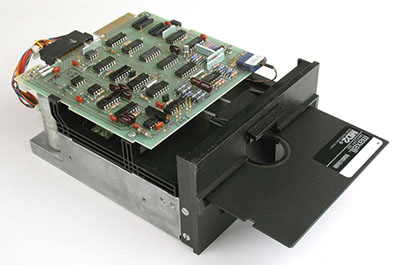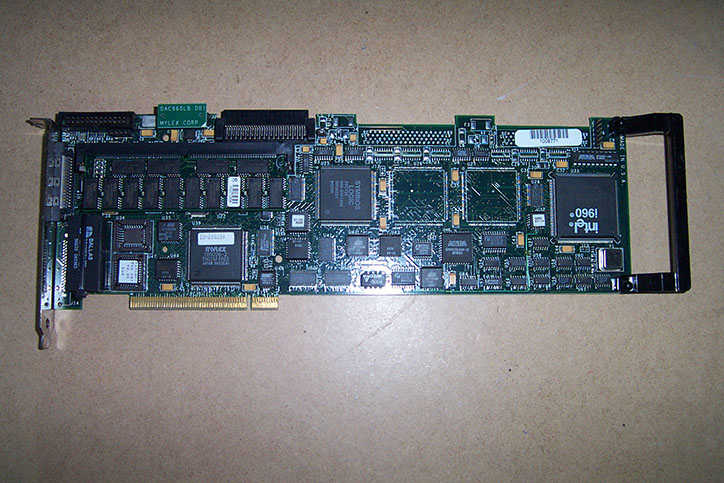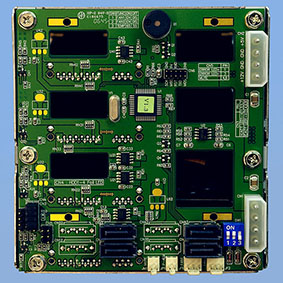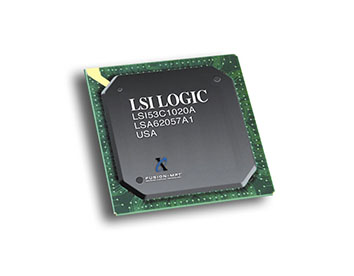Live SCSI
Since we started to look at the history of data storage, let's take a closer look at one of the technologies that we mentioned only briefly in the last article. What is surprising about this technology is that, having appeared at the very beginning of the 80s, it has survived to the present with various changes and is not going to give up its position. It's about SCSI.
The founding fathers of SCSI can be considered Shugart Associates, the standard from which SCSI was born subsequently initially wore the name SASI (Shugart Associates System Interface), which was slightly inconsistent for the Russian ear. This company, now not so widely known, almost dominated the drive market in the late 70s, and it was this company that offered the popular 5¼ inch format. SASI controllers were usually half the size of a disk and connected with a 50-pin flat cable, which later became a SCSI-1 connector.

')
The standard was renamed ANSI, which by 1982 had developed a standard for this interface. The fact is that the ANSI policy does not allow the use of company names for the standards, so SASI was renamed the Small Computer System Interface, which gave us an abbreviation familiar to us. The “father” of the standard Larry Boucher (Larry Boucher) wanted this abbreviation to be read as “Saxie,” but the reading from Dal Allan (Dal Allan) “Toldi” got accustomed more.
Despite the fact that SCSI is generally associated with hard disks, this standard allows you to create virtually any device connected via this interface. With SCSI, mass devices were produced: hard drives, magneto-optical drives, CD and DVD drives, tape drives, printers, and even scanners (the LPT port was too slow for high-resolution color scanners to work).
Despite the fact that in most “simple computers” SCSI as an interface is not found, the command set of this standard is widely used. For example, the SCSI command set is software implemented in a single Windows stack to support storage devices. Also, the implementation of SCSI commands over IDA / ATA and SATA interfaces used for working with CD / DVD and BlueRay, called ATAPI, has become almost standard. Also, this command system, implemented on top of USB, has become part of the Mass Storage Device standard, which allows the use of any external USB data storage.

Historically, the first interface was Parallel SCSI, using 50, 68 and 80 pin connectors located on a flat cable, often shielded. This standard has evolved over the years, going from 40 Mbit / s in SCSI-I to 5120 Mbit / s in Ultra-640 SCSI. Despite this progress, this interface has already been recognized as obsolete, and is being replaced by a more advanced solution in the form of Serial Attached SCSI (SAS), but about SAS - a little later. For now, let's see what other cable interfaces were used in SCSI.
The implementation of the SCSI protocol over optical fiber channels, called FCP (Fiber Channel Protocol or FC), allows you to achieve high speeds and use connecting cables of great length (up to tens of kilometers using single-mode optics). Because of the high cost used in large data processing networks. Today, FC is used only for the so-called "front-end", that is, to connect computers (mainly servers) to storage systems.

iSCSI, as is clear from the first letter in the title, serves to process SCSI commands over the Internet, but is most often used in companies ’local IP networks. Since this standard, unlike FCP, does not require expensive equipment, it often acts as a cheaper replacement for “optics”. The main two scenarios for applying this standard are storage consolidation (data instead of scattered network storages are collected in one place, most often in data centers) and failover protection (iSCSI allows consumers to move disk arrays transparently across the global network). iSCSI is highly dependent on the physical and channel levels of the network model, which determine the speed and maximum delays in the environment. So, iSCSI on 1Gb / s Ethernet allowed to transfer only up to 100MB / s. Things are much better in 10GE networks, but 10GE technologies are only now winning significant segments in corporate networks.
SCSI RDMA Protocol (often abbreviated to remote SCSI) allows one computer to connect to the resources of another, using the remote direct memory access protocol. Since RDMA is characterized by low latency and high bandwidth, it is most widely used in clusters.
USB Attached SCSI is also clear from the title. Implements SCSI connectivity via USB interface. In theory, it is capable of providing speeds of up to 3200 Mbps.
Serial Attached SCSI - the most common type of interface now, replacing the old parallel version. Provides speeds of up to 6 Gbps (12 Gbps version is in active development and will be released in the summer of 2013). This protocol is the “closest relative” of the currently used SATA, moreover, SATA devices can be connected to SAS controllers. In the opposite direction, however, it does not work, and even the SAS connector is designed not to allow it (except that the system builder will be very strong).
Unlike the old parallel SCSI, SAS systems have the following advantages:
- fewer signal lines, therefore more compact wires;
- the use of a point-to-point connection, in contrast to the P-SCSI, which used the bus, because of which only one device could work simultaneously with the controller;
- SAS does not need a special cable terminator attachment;
- the new protocol does not suffer from the problem of not simultaneously passing a signal through different wires in the bus;
- the number of simultaneously supported devices has dramatically increased, old SCSI supported from 8 to 32, new - more than 16384;
- SAS gives a higher bandwidth, and what is especially good is that this bandwidth is effectively used between each initiator and the target device, while on a parallel SCSI bus bandwidth was divided equally between all devices;
- compatible with SATA devices

The history of LSI is also inseparable from the storage history, SCSI and SAS. Being one of the first companies in the world to implement ASIC (Application Specific Integrated Circuit) devices — specialized chips designed to perform dedicated tasks, LSI could not get past such a booming area. For LSI, the history of SCSI began with the acquisition in 1998 of the Symbios division, at one time the former part of NCR, AT & T and Hyundai. This unit was founded in NCR in 1971 and at the time of the acquisition was the manufacturer of SCSI adapters. The range of devices released by LSI begins with the LSI53C825AE chip, which allowed to skip up to 20MB / s of data and complied with the Fast Wide SCSI standard. In the development process, a so-called Fusion-MPT (Message Passing Technology) architecture was developed, which allows for the “easiest” device driver in the operating system and speeds up the process of communication between the components of the I / O subsystem. This technology has survived to today's SAS-3 devices (12Gbit / s), which are more than three orders of magnitude faster than the first SCSI chips. In addition to controllers, for SCSI, LSI also produced other microcircuits, such as host adapters and SCSI converters (extenders).
Not to mention another interesting fact. Most recently, Seagate announced the release of a two billionth hard drive. A hard disk is a very high-tech device containing a large number of different components. LSI released and continues to produce quite a lot of chips for hard drives. Traditionally it was “Read Channel”, now there are so-called SOCs (System on Chip) for this.

Another major player in the SCSI market was Adaptec. Unlike LSI, which has always worked closely with the OEM channel, Adaptec focused mainly on finished products, and therefore is better known in the IT world under its own name. About two years ago, the company was acquired by the manufacturer of semiconductor devices PMC and now the company's products are called Adaptec by PMC. The company also successfully survived all generations of SCSI and is now releasing devices for SAS.
The history of Parallel SCSI was long and turbulent, but in the end, ended. For more than two years, P-SCSI adapters have not been produced, having given way to SAS technology, which already numbers 2 generations.
We hope that our acquaintance with the world of SCSI devices was interesting to you, and in the next article we will continue it, having considered SAS in more detail and in details.
The founding fathers of SCSI can be considered Shugart Associates, the standard from which SCSI was born subsequently initially wore the name SASI (Shugart Associates System Interface), which was slightly inconsistent for the Russian ear. This company, now not so widely known, almost dominated the drive market in the late 70s, and it was this company that offered the popular 5¼ inch format. SASI controllers were usually half the size of a disk and connected with a 50-pin flat cable, which later became a SCSI-1 connector.

')
The standard was renamed ANSI, which by 1982 had developed a standard for this interface. The fact is that the ANSI policy does not allow the use of company names for the standards, so SASI was renamed the Small Computer System Interface, which gave us an abbreviation familiar to us. The “father” of the standard Larry Boucher (Larry Boucher) wanted this abbreviation to be read as “Saxie,” but the reading from Dal Allan (Dal Allan) “Toldi” got accustomed more.
Despite the fact that SCSI is generally associated with hard disks, this standard allows you to create virtually any device connected via this interface. With SCSI, mass devices were produced: hard drives, magneto-optical drives, CD and DVD drives, tape drives, printers, and even scanners (the LPT port was too slow for high-resolution color scanners to work).
Despite the fact that in most “simple computers” SCSI as an interface is not found, the command set of this standard is widely used. For example, the SCSI command set is software implemented in a single Windows stack to support storage devices. Also, the implementation of SCSI commands over IDA / ATA and SATA interfaces used for working with CD / DVD and BlueRay, called ATAPI, has become almost standard. Also, this command system, implemented on top of USB, has become part of the Mass Storage Device standard, which allows the use of any external USB data storage.

Historically, the first interface was Parallel SCSI, using 50, 68 and 80 pin connectors located on a flat cable, often shielded. This standard has evolved over the years, going from 40 Mbit / s in SCSI-I to 5120 Mbit / s in Ultra-640 SCSI. Despite this progress, this interface has already been recognized as obsolete, and is being replaced by a more advanced solution in the form of Serial Attached SCSI (SAS), but about SAS - a little later. For now, let's see what other cable interfaces were used in SCSI.
The implementation of the SCSI protocol over optical fiber channels, called FCP (Fiber Channel Protocol or FC), allows you to achieve high speeds and use connecting cables of great length (up to tens of kilometers using single-mode optics). Because of the high cost used in large data processing networks. Today, FC is used only for the so-called "front-end", that is, to connect computers (mainly servers) to storage systems.

iSCSI, as is clear from the first letter in the title, serves to process SCSI commands over the Internet, but is most often used in companies ’local IP networks. Since this standard, unlike FCP, does not require expensive equipment, it often acts as a cheaper replacement for “optics”. The main two scenarios for applying this standard are storage consolidation (data instead of scattered network storages are collected in one place, most often in data centers) and failover protection (iSCSI allows consumers to move disk arrays transparently across the global network). iSCSI is highly dependent on the physical and channel levels of the network model, which determine the speed and maximum delays in the environment. So, iSCSI on 1Gb / s Ethernet allowed to transfer only up to 100MB / s. Things are much better in 10GE networks, but 10GE technologies are only now winning significant segments in corporate networks.
SCSI RDMA Protocol (often abbreviated to remote SCSI) allows one computer to connect to the resources of another, using the remote direct memory access protocol. Since RDMA is characterized by low latency and high bandwidth, it is most widely used in clusters.
USB Attached SCSI is also clear from the title. Implements SCSI connectivity via USB interface. In theory, it is capable of providing speeds of up to 3200 Mbps.
Serial Attached SCSI - the most common type of interface now, replacing the old parallel version. Provides speeds of up to 6 Gbps (12 Gbps version is in active development and will be released in the summer of 2013). This protocol is the “closest relative” of the currently used SATA, moreover, SATA devices can be connected to SAS controllers. In the opposite direction, however, it does not work, and even the SAS connector is designed not to allow it (except that the system builder will be very strong).
Unlike the old parallel SCSI, SAS systems have the following advantages:
- fewer signal lines, therefore more compact wires;
- the use of a point-to-point connection, in contrast to the P-SCSI, which used the bus, because of which only one device could work simultaneously with the controller;
- SAS does not need a special cable terminator attachment;
- the new protocol does not suffer from the problem of not simultaneously passing a signal through different wires in the bus;
- the number of simultaneously supported devices has dramatically increased, old SCSI supported from 8 to 32, new - more than 16384;
- SAS gives a higher bandwidth, and what is especially good is that this bandwidth is effectively used between each initiator and the target device, while on a parallel SCSI bus bandwidth was divided equally between all devices;
- compatible with SATA devices

The history of LSI is also inseparable from the storage history, SCSI and SAS. Being one of the first companies in the world to implement ASIC (Application Specific Integrated Circuit) devices — specialized chips designed to perform dedicated tasks, LSI could not get past such a booming area. For LSI, the history of SCSI began with the acquisition in 1998 of the Symbios division, at one time the former part of NCR, AT & T and Hyundai. This unit was founded in NCR in 1971 and at the time of the acquisition was the manufacturer of SCSI adapters. The range of devices released by LSI begins with the LSI53C825AE chip, which allowed to skip up to 20MB / s of data and complied with the Fast Wide SCSI standard. In the development process, a so-called Fusion-MPT (Message Passing Technology) architecture was developed, which allows for the “easiest” device driver in the operating system and speeds up the process of communication between the components of the I / O subsystem. This technology has survived to today's SAS-3 devices (12Gbit / s), which are more than three orders of magnitude faster than the first SCSI chips. In addition to controllers, for SCSI, LSI also produced other microcircuits, such as host adapters and SCSI converters (extenders).
Not to mention another interesting fact. Most recently, Seagate announced the release of a two billionth hard drive. A hard disk is a very high-tech device containing a large number of different components. LSI released and continues to produce quite a lot of chips for hard drives. Traditionally it was “Read Channel”, now there are so-called SOCs (System on Chip) for this.

Another major player in the SCSI market was Adaptec. Unlike LSI, which has always worked closely with the OEM channel, Adaptec focused mainly on finished products, and therefore is better known in the IT world under its own name. About two years ago, the company was acquired by the manufacturer of semiconductor devices PMC and now the company's products are called Adaptec by PMC. The company also successfully survived all generations of SCSI and is now releasing devices for SAS.
The history of Parallel SCSI was long and turbulent, but in the end, ended. For more than two years, P-SCSI adapters have not been produced, having given way to SAS technology, which already numbers 2 generations.
We hope that our acquaintance with the world of SCSI devices was interesting to you, and in the next article we will continue it, having considered SAS in more detail and in details.
Source: https://habr.com/ru/post/173619/
All Articles